“Tossing a bit of dry grass in the air as he had done at countless high-power matches, T.K. judged the wind. He complained, ‘Darn, I wish I had a windage table for .50 Browning. I’ll just have to guesstimate.’ Getting ready for his first shot seemed to take forever. First, he made several adjustments to the bipod. Then he squirmed around trying to get into a comfortable prone position. He tried placing his cheek on the stock several times before he found a position that was both comfortable and provided a full field of view through the rifle’s ten-power Leupold scope. Next, he concentrated on getting himself relaxed and controlling his breathing. Then, and only then, did he pick his primary and secondary targets.
‘I’ll spot for you,’ Dan said, as he pulled out his binoculars. Dan lay propped up on his elbows, peering through the rubber-armored seven-by-fifty Steiner binoculars. ‘What do you make their range, about eight hundred?,’ Fong asked.
‘More like nine-fifty,’ T.K. remarked coolly.” (Patriots, p. 229).
If reading the novel Patriots doesn’t get you pumped up, maybe you’re on the wrong web site. In this article, I provide a “how-to” on long-range shooting by showing you how to range targets using a mil-based reticle and ways to read the wind.
Long-range shooting works well with prepping because being true to the meaning of the word, you need to prepare in advance so that your end result meets your expectations. Shooting at longer ranges requires an advanced understanding of several things, but, I assure you, it is not hard once you get into it.
Shooting at longer distances does require practice and patience, however. Long range is also not for everyone due to several factors such as firearms interest, cost, and range availability. Or, maybe your general location won’t allow you to see beyond 200 yards. However, if you are sitting at your retreat, or at your home and you can see further than 200 yards, then learning how to use a mil based reticle can help you in the most basic sense of just calculating distance.
The technique of ranging distance can also help to better assess your environment, too. There are spotting scopes and monoculars on the market that come with a mil-based ranging system etched into the glass. So, this technique can work for simply observing through an optic that is not attached to a firearm.
Scopes are a very important part of this equation and they come in all sorts of shapes, sizes, features and prices. I am of the opinion that the most important part of selecting a scope for long range is to make sure that the reticle and turrets match.
This is to say that if you are working with mils, then both your reticle and turrets should also be in mils. When I first became interested in long-range shooting, the most widely available scopes had mil-dot reticles with MOA turrets. Those scopes required an equation to convert the different units of measure and that conversion was another step that made everything more complex than it needed to be. As mentioned, this article is focused on the mil based system, so for you MOA shooters, that information is for another article.
A main feature of a scope is that they have either a First Focal Plane (FFP) or a Second Focal Plane (SFP) option. Either option is a personal preference. A major difference between FFP and SFP for the end-user is that with a FFP scope, it does not matter which power your optic is set at to measure distance.
With a SFP scope, there is usually a number marked in a different color on the power adjustment ring. It is common for that number to be at 10 or 12 power but it may vary depending on the manufacture and model of your scope. The particular setting that is colored differently on a SFP power adjustment ring is the setting your scope needs to be at in order for your reticle to measure true distance.
The quick way to know if a scope features FFP is that when you adjust the power ring, the reticle will move by either growing in size or shrinking as you move the power adjustment. On a SFP scope, the reticle will always stay the same size when adjusting the power ring.
Understanding the reticle
When breaking down a mil-based reticle, there is the center crosshair with a line traveling up the “Y” axis which connects to circles. These circles represent mil dots and are whole numbered mils. The same is found on the “X” axis. From the center of the crosshair to the center of the first dot, that distance equals 1 mil. The second dot would be 2 mils and so on.
Between the center crosshair and the first mil-dot as seen in Figure 1, that distance is broken down into .1 increments. Being invisible on this particular reticle, these tenth of mil increments are used to measure objects and they correlate to the turret adjustment. In Figure 1, the halfway point between the center crosshair and center of the first mil dot equals .5 mils. The point in which the line just touches the bottom of the first circle, that spot would equal .9. The center of the first mil-dot equals 1.0, or 1 whole mil.
The same unit of measure holds true for the entire reticle. This is to say that the point at which the first mil-dot connects to the line again (top side and opposite of .9), that would be 1.1 mils. The center of the next stadia would be 1.5 and so on.
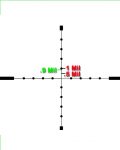
Measuring Distance
Now that we have a basic understanding on how to use the reticle, how do we use this information to measure distance? To measure distance in yards, you will use this equation.
27.778 X inch size/mils = distance.
Inch size and mils are always going to be variables (they will always be different with different targets), but 27.778 will always be a constant for yards (for meters, the constant is a different number). 27.778 will never change for measuring yards, so when you get out in the field to practice, you may want to memorize 27.778.
When looking at inch size in the equation above, you need to know the size of the object you want to measure. This means that if you are looking over a field or a tree line, you would need to know the size of a particular tree, as an example, in order to range it (almost impossible or takes way too long on the front end prep). However, if you see a coyote, a deer, or even a fence post, you can take the average size of that object to gauge its distance.
In the case of ranging deer, you can measure from chest to tail, or hoof to the top of the back (do not use the head as it is always moving).
As seen in Figure 2, we are measuring a doe from the hoof to top of back (top of front shoulder) using an average height of 36 inches.
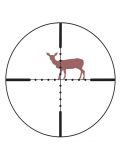
From the hoof to the top front shoulder blades, Figure 2 is showing 3.1 mils. Plugging our numbers into the equation we get:
27.778 x 36”/3.1 mils = 322.6 yards.
Does this seem pretty straight forward? Let us try another example as seen in Figure 3.
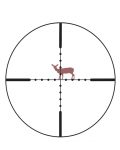
In figure 3, I would measure the doe at 1.9 mils, and plugging our numbers into the equation we get:
27.778 x 36”/1.9 mils = 526.3 yards.
Getting the hang of it?
I have included a third reticle image (Figure 4), so that for those of you interested, you can practice by posting your answers in the comments section.
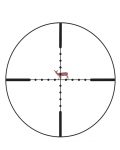
Now that we have learned to range distance using a mil reticle, how does this information help us in making a long-range shot?
Bullet Trajectory
The key here is to know how fast your bullet is traveling. Referred to as Feet Per Second (FPS), you can collect the data for your FPS by using a chronograph (chrony). Most factory ammo has an FPS listed on the box, but I have never seen that number actually be true. There are several reasons for this, but that is beyond the focus of this article (barrel length, powder charge, type of power, bullet weight, distance between muzzle and chrony, and or temperature). However, using the factory FPS can work in a generalized sense, but the further out you go, the less accurate generalized information becomes.
To calculate FPS, shoot 10 rounds through the chrony and then take the average of those 10 rounds. The outdoor temperature when you chrony can also affect your FPS. For instance, if you chrony on a 80 degree day but later use that data during the winter, the atmospheric conditions have changed and the air becomes thicker in colder weather. This in turn slows down your bullet. On hot days, the air is thinner, thus allowing your bullet to travel faster. The differences in temperature (and altitude) can determine if you are high, low, or miss your target entirely. Really just depends on how far out you are going. Being mindful of these atmospheric changes, you may benefit by collecting chrony data for 20, 50 and 80 degree weather.
Once you have your FPS, there are all sorts of programs and ballistic apps on the market that will allow you to plug-in your FPS. These programs will give you your flight trajectory (drop) as well as tell you how many “clicks” you need to adjust your scope for a particular distance (more on clicks below).
I personally do not use a phone app, but I see many people do. I use a ballistics program on my computer which allows me to enter my FPS, atmospheric conditions and the bullet I use in order to generate a range card. I divide my range card into 50-yard increments out to the distances I would intend to shoot for a particular caliber (0 to 1000 yards in a good place to start). I then print that range card, use a poor-man’s laminate (clear packing tape), and either tape that card to the rifle stock, place a duplicate in an admin pouch, or use a referee-style wristband with a card slot to store the range card.
Turrets
Ballistic apps and data cards will calculate your drop and this could be thought of as “clicks” in adjustment of your turrets in relation to a particular distance. At the beginning of this article I talked about being sure to have your reticle and turrets match. Then having explained how to use your reticle, that reticle translates to your elevation and windage turrets.
One “click” on your turret equates to .1 mil of adjustment on the reticle. Turning both clockwise and counter-clockwise for the elevation, the turret will adjust your point of impact (POI) or point of aim (POA). The same holds true for your windage adjustment (left and right). As can be seen in Figure 5, these tenth-of-mil increments are marked on the turret, with the number “1” equaling 1 mil or 10 clicks.
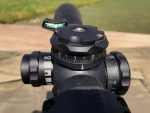
Returning to Figure 2 in which we ranged that deer at 322 yards, we would then look for that distance on the data-card to find 300 and 350 yards. In an example, let us say our data shows 1.3 clicks for 300 yards and 1.7 clicks for 350 yards. As our target is at 322 yards, try splitting the difference with perhaps a 1.5 value for elevation adjustment. 1.5 mils are equal 15 clicks on the elevation turret. Make sense? If not, please let me know in the comments section and I will try to answer your question the best that I can.
(To be concluded tomorrow, in Part 2.)

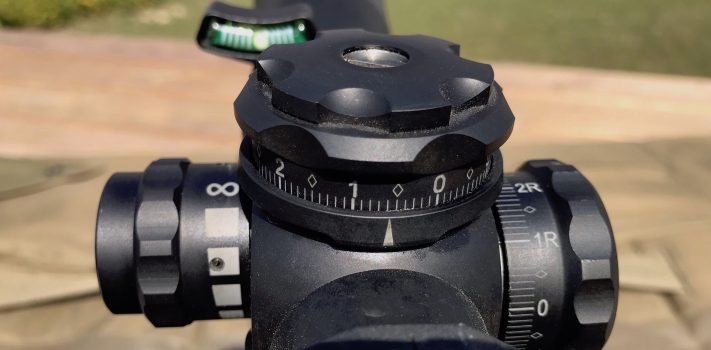









How do you determine friend from foe past 200 yards? In a Fictional Novel the Enemy is always WELL DEFINED and oddly easy to spot at extreme ranges… My local deer have better camouflage than the “Evil Doers” everybody is going to “Fight”.
When I was in the Sandbox with all our technology we *still* managed to fire upon our own folks. That with uniforms and communications. In a civil war no uniforms, no communications and many different groups operating in potentially the same area of operations?
But then again in the civilians viewpoint is any armed group with hungry bellies and questionable morals a friendly? Civilians in the Bosnian Civil War, the Spanish Civil war and Southerners in the American Civil War might say all armed men roaming around are trouble. As the lyrics of “The night they drove ole Dixie down they speak of “Friendlies “We gave you what we can but Why did you have to take the very Best”?
If you have more money in your weapons than you have in safe water-food-shelter how long are you going to go before that Gun looks like a Credit Card?
Beware squirrel hunters they hunt the crafty alert target with stealth and a single shot at a tiny target. Your left ear is bigger. The rest of your squad might get that old man but your squad is one man down. And the hidden eyes saw you kill him.
Plan on how your going to ID friendlies and how to BE Friendlies when things get spicy.
Michael,
This article was written in the spirit of marksmanship and firearms safety. Knowing exactly where a projectile will go and now far it can travel is fundamental to firearms safety.
PRS (Precision Rifle Series) is the fastest growing sport in the firearms industry. Not everything is about self defense, and nothing in this article is about self defense from humans. This is why deer are selected as the example in order to put food on the table.
I used to shoot iron ram Ok. But it was before the “Patriots” novel you led the article in with.
I doubt they were using a 50 caliber BMG to shoot a deer at …
My comment still stands, how do you ID and how do you ID yourself as a “friendly” past 200 yards.
Perhaps you could write an article about that topic.
When I drive down a two lane road, I have some manner of trust that the person traveling toward me, in their lane, will maintain control of their vehicle. This article is about firearms safety, not attacking humans. I trust that we can keep the comments in the lane of safety, education and skill. Thanks.
It can be awfully hard to positively identify friend vs. foe in face-to-face conversation. It often takes years of observation to really get to the bottom of who people are–even if you’re married to them.
On the other hand, intelligence that has been accumulating for years can help in differentiating friend from foe, and there can be decisive moments when action must be taken based on the accumulated intel.
cf how VERY True that is. And until you see folks under stress your not sure who your talking to. Recently I had a member of ours show great weakness over his wife’s disagreements with someone in the group and it was very concerning.
Betrayal is a tool the Communists have used to destroy dissenters. So far not a betrayal situation but could become one.
I’d like to find some of that intelligence accumulating for years in differentiating friend from foe.
I tend to use Luke 6:43-45
43 “For a good tree does not bear bad fruit, nor does a bad tree bear good fruit. 44 For every tree is known by its own fruit. For men do not gather figs from thorns, nor do they gather grapes from a bramble bush. 45 A good man out of the good treasure of his heart brings forth good; and an evil man out of the evil [a]treasure of his heart brings forth evil. For out of the abundance of the heart his mouth speaks.
I listen to their words carefully, I measure their words by their actions. I beware of easily angered people (although it seems I failed with my friends wife) per Proverbs 22:24-25
24Do not make friends with an angry man, and do not associate with a hot-tempered man,25or you may learn his ways and entangle yourself in a snare.…
We are coming into a situation America hasn’t been in since Harpers Ferry and it seems they are pushing to create a Harpers Ferry.
N.E. even though I’ve been involved in post action study groups to reduce “Friendly Fire” incidents I really Don’t KNOW myself.
Thus I ask because it’s been a serious question each time WE have Long Range shooting exercises with spotters.
Hitting a “Deer” at 833 yards is an interesting intellectual discussion. I don’t know if I did and then hiked over there to collect it I’d ever find it 🙂 It’s a tad hilly and wooded here.
When I served in Bosnia there were snipers shooting at random civilians from very far away getting crippling hits. But they were shooting into the Christian held areas for terror effects.
You may not be able to identify friend or foe past 200 yards but if you start receiving fire from that position that would be what the FBI calls a clue and you darn sure better be able to return fire…accurately, and that is what makes this article very relevant.
To the author in your last section you say 1.7 and 1.3 clicks and I believe you mean 1.7 and 1.3 MILS or 17 and 13 clicks.
Technically, you are correct. Thanks for pointing that out.
Long-range shooting is a skill using a specific tool. Being able to engage an enemy from beyond their effective range gives a defender an advantage. Also, it gives you the chance to conduct anti-materiel shooting before those things are used against you. It is also a force multiplier when used against superior numbers at distance.
Fratricide happens. Some folks say the War of Northern Aggression was lost when Stonewall Jackson was shot by his own men. And the more recent death of Pat Tillman was a national tragedy.
Matt Bracken has warned that the coming conflict may see folks being shot because of the color of their skin because that is a distinguishing feature at distance and folks may self segregate.
If you wait until someone is close enough to identify, they may overwhelm and kill you.
High power optics, radios, drones and other signals can be used to Identify friend or foe. Look at the arm bands used in the recent street fighting… Below are some links to military manuals discussing challenges and passwords.
This is the horror of the coming conflict as we go from a high trust society to a low trust one… A lot of good folks will die needlessly.
https://www.trngcmd.marines.mil/Portals/207/Docs/TBS/B141136%20Responsibilities%20of%20The%20Interior%20Guard.pdf?ver=2015-06-03-160800-630
https://armypubs.army.mil/epubs/DR_pubs/DR_a/pdf/web/ARN20188_TC%203-22×6%20C1%20FINAL%20WEB.pdf
Armbands for ID?
I recall when a friend organised a paintball weekend for his bachelor party. At the end the staff asked for the armbands, red team first. I handed mine over. Then they asked for the blue teams, and I opened a pocket and handed mine over. I got a nasty look. As he was about to go I asked him if he wanted my yellow judges’ armband too 😉
Thanks Anonymous.
https://www.breitbart.com/clips/2020/10/19/mo-brooks-theres-going-to-be-more-voter-fraud-this-election-than-any-election-in-the-history-of-the-united-states/
It’s interesting that even nonbelievers and non spiritual (Agnostics and atheists)… Are gearing up for a conflict. I’m trying to get my own family and household ready as calmly and prayerfully as possible.
Hope and pray for the best but prepare yourself for the worst in our lifetime.
Michael,
Your questions and statements are pertinent. We were taught to always be certain of our target before firing. An ideal seldom met in battle.
Re: “Friendly Fire”, Lt. Col. David Hackworth, on assignment from the Pentagon, established with some veracity that fully one third of US casualties were from American ordnance.
Like you say, even with optics and comms.
Sighting in is important. Then the question becomes, “Sighting in on what?”
Carry on
833.3 yards?
If we’re talking precision I’ll go with 833.34 🙂
Using 1.2 mil reading from the scope I arrived at 833.34 yards
Great article. Looking forward to part 2
Thanks for the very informative and understandable orientation to MILS. I’m not in long distance shooting country, but was always curious how the MILS to Range Distance worked.
It spurred me on to research how this works in Metric (very easy 10 multiplier for Meters) as well as how ranging using MOA works.
833.24 yards!
EXCELLENT article. It all just came clear to me finally!! A grest day to learn something new and be able to comprehend it. Thank you N.E.
I am not a soldier but i guess a sure fire way to determine friend or foe is, are they shooting at me or mine. Not to downplay the seriousness of that particular situation.
I read this article in the context of using a mil.dot reticle in a scope and how it works and I was rewarded with new knowledge. God Bless you all
I used 1.1 for 909.09. using 1.2 I got 833.4.
769
Powerful insights for those of us who are not fully schooled in technical aspects.
We all need to have the basics under our belt. I’m no expert, i’m intermediate (not too cool for school!). I know that lack of basic firearm and ballistics leads to poor results. In hunting or self/home defense.
RANT:
The times are serious, critical for most American cities.
It’s amazing that they’ve turned this COVID-19 into a vote by mail manipulation. It appears they can only beat Trump by stealing the vote (and accusing him), or outright sabotage. We are on the precipice of disastrous results- expanding from now thru elections. It may be dragged out after the elections into Christmas/New Year 2021.
-The media has disproportionate influence, always Blaming the Trump administration for every aspect that the communist Chinese created. Many leaders have argued that the media has more power than Congress or the Senate. Sen. Josh Hawley has done a great job, including exposing Google/Fakebooks deceitful manipulations. The Google antitrust lawsuit is long overdo. They are dividing America’s culture for their own $$$$ self gain.
For example Pres. Trump has record black/Latino support, but they obfuscate it, deliberately.
God bless, guide and lead SB staff and ALL readers, in Jesus’ name!
Hello N.E., i was sharing this article today with a friend and the question he had was how does magnification of your scope effect the height of a deer in the math equation?
Mn Dan,
If I understand your question correctly, it wouldn’t effect the height of the deer. If you have a FFP scope, the reticle moves in relation to the magnification and always remains true to measurement. If you have a SPF scope, it would impact the equation if you are not on the correct power setting for the reticule to be true.
What would impact the height of the deer is the average inch size that a person uses for the deer. As an example, I use the average height of 36″ in this article. That would not be the case for a large buck. Deer can range between 36 and 42″ from hoof to top shoulder blade.
Interesting article, I’m almost certain that everyone used a calculator to estimate the distance, including me. The question is, how will you estimate the distance the day you don’t have one?
Luis,
I carry a calculator with my gear. You can buy a small calculator wrist watch, too. At longer distances, you have time to do the math. Or, you could do the front in prep by ranging certain trees, hay bails or anything else that can act as a marker for distance.
I am surprised no one has yet mentioned a digital range finder. In my experience, those only work well out to about 400 yards unless you have a really high-end one.
The answer is in the excellent explanation. =
MEASURING DISTANCE
Now that we have a basic understanding on how to use the reticle, how do we use this information to measure distance? To measure distance in yards, you will use this equation.
27.778 X inch size/mils = distance.
Inch size and mils are always going to be variables (they will always be different with different targets), but 27.778 will always be a constant for yards (for meters, the constant is a different number). 27.778 will never change for measuring yards, so when you get out in the field to practice, you may want to memorize 27.778.
When looking at inch size in the equation above, you need to know the size of the object you want to measure. This means that if you are looking over a field or a tree line, you would need to know the size of a particular tree, as an example, in order to range it (almost impossible or takes way too long on the front end prep). However, if you see a coyote, a deer, or even a fence post, you can take the average size of that object to gauge its distance.
In the case of ranging deer, you can measure from chest to tail, or hoof to the top of the back (do not use the head as it is always moving).
As seen in Figure 2, we are measuring a doe from the hoof to top of back (top of front shoulder) using an average height of 36 inches.
From the hoof to the top front shoulder blades, Figure 2 is showing 3.1 mils. Plugging our numbers into the equation we get:
27.778 x 36”/3.1 mils = 322.6 yards.
*********************************************************
*****
[A Redoubt-Region hunter would not shoot a peewee sized deer only 3 feet tall; measuring up to the top of a deer’s back, (In the Redoubt Region, the Bucks (a male deer) reach 48 inches at the shoulder. ~ In Alaska, the mosquitos grow bigger than that!) … A person has to know the general size of their target.
*****************
*****
For a good explanation on estimating distance and windage, it’s possible to watch WW-2 US Army training films on YouTube (for free): = ~Elevation & Windage – Rifle Marksmanship with the M1 Garand Rifle (1942)~ (parts 1,2 and 3)
[Even a US Marine would admit, the US Army does a good job teaching >how to shoot; though NOT as good as the Corps!]
The videos teach shooting with M1 Garand military ~iron sights. The ‘clicks’ are explained. A scope will give a shooter magnification. (Scopes generally have a ‘click’ adjustment for Elevation and Windage)
…….. The total length of the Army videos will be less than 30 minutes. There are, also, more modern videos on shooting, available on YouTube. [The basics are worth reviewing.]
Rawles has an article here at SurvivalBlog titled ~Un-Zeroed Rifles are Just Voodoo Talismans~ A person has to get the basics in place before target shooting, or safely hunting.
Brownells (linked here at SurvivalBlog) sells paper targets, which are marked for making adjustments with the ‘click’ dials on the scope. [Nothing beats skills, developed through practice.]
Wind speed measurement requires a gauge, or making a knowledgeable estimate. The US Army training films will help with the estimate. [Not a guess!] … On the Internet are modern videos with explanations about accurate shooting.
The US Military just has experience with teaching millions of nonshooters how to shoot accurately.
The spring and summer 1965, the school I attended had a high-power rifle team…I was a member. We had Match-Grade M14s with iron sights. We went to a few rifle matches, trained intensely and went to Camp Perry that summer. One of the events was Rattle-Battle – I don’t remember all the details, but there were 4 or 5 of us, prone, shooting at several targets out there at 500 yards (or was it 400, or 600?), just as fast as we could pull the trigger and change mags, for 1 minute.
The central point here is our team coach, SgtMaj O’Neil…there was a strong wind blowing across the range, about 30 mph, and we could hear other team coaches calling out “36 clicks left windage”, “40 clicks left”, “32 clicks left”. Our coach pulls a handful of grass, drops it, watches it blow away, pretty much horizontally, then calls out “6 clicks right windage and hold on the target to the left of the one you are assigned”. Our team was high score on that event.
Great article, I need this for our future. I used to have a Russian Izhmash with a 4 power scope, .223/5.56. I liked it because the reticle had the cross hairs etc but off to the side was a downward curve with markings for 100, 200, 300 and 300 meters. The markings were such that putting a 5’8” target between the lower horizontal line and the sloping line gave a pretty good estimate of distance, it had a fixed 4x scope similar to what Russian snipers used in WWII. I’ve never found a scope for sale here that was 4x with that reticle. Loved it but sold it. Not my only regret. I’ll have to study this article more, I might need it,
Thank you and God Bless.
NE, I found both parts of your article EXTREMELY helpful, clear and informative. Well written and MUCH APPRECIATED! THANK YOU